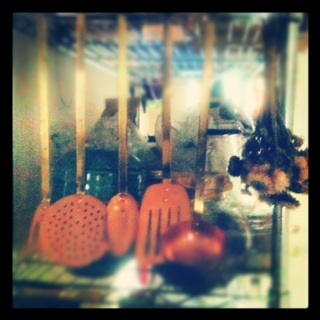 Happy national pie day, a bit belated. The true date for the holiday was this Saturday January 23rd but it's never too late to celebrate or discuss pies.
Happy national pie day, a bit belated. The true date for the holiday was this Saturday January 23rd but it's never too late to celebrate or discuss pies.In honor of the day I prepared a pie recipe that I've had bookmarked for quite some time. This seemed a very exciting and mysterious recipe because of the supposed party trick that it involves. Please, allow me tell you all about it.

You see, I am a proud member of the of the pie of the month club.
In addition to the fabulous pie of the month club t-shirt and buttons that I received, my membership entitles me to a monthly postcard that features lovely pie art, as well as a fun recipe along with a brief description of the pie.

Truth be told I have not baked many of the recipes from the postcards thus far. Sometimes the pies just sound too weird (For example: watermelon rind pie? I dunno, maybe I'll save that for a summer day on which I'm feeling particularly adventurous).

For now though it was the funny cake pie that caught my attention. The pie features two layers, chocolate and vanilla, with the vanilla layer being especially cake-y in consistency and the chocolate one being more of a cocoa powder goo (which is very tasty and not gross the way the word "goo" sounds).
The recipe boasts that this cake-pie is funny because of a " funny " thing that happens to the two layers: In the pie preparations, you layer the chocolate under the vanilla and then, during the baking process, the two layers flip such that the chocolate layer ends up above the vanilla.
Yes, you read that right. A pie crust with chocolate + vanilla layers that do back flips in the oven. After reading that I was intrigued and just had to try the recipe out.

Let me say that this pie turned out being delicious. Honestly I was surprised by how tasty the end product was because in the end I was a bit tentative about the idea of putting a cake batter in a pie crust. However, I regret that I must also note that I was utterly disappointed by the fact that there was no switcharoo magic that occurred between the two layers in the pie. I had excitedly put the vanilla atop the chocolate and yet the pie came out of the oven with the layers...drum roll...in the same order.
Now, after having performed a google search for other recipes for funny cake pie, I am suspicious that there was a mistake in the pie of the month club recipe. In fact, I think that the chocolate layer should have gone over the vanilla layer and then ended up on the bottom following baking. If anyone reading this has any thoughts about this, or experience baking this particular pie, I'd love to hear them! For now I will say that the next time I bake this pie I plan to layer the chocolate on top of the vanilla and hope for the best in terms of cartwheeling magic between the layers.
In any case, I have reproduced the Pie of the Month Club recipe for Funny Cake Pie below, as it was written on my postcard, but I noted the place in the recipe that I believe to be erroneous. Happy baking and let me know if you manage to get your layers to flip!

Funny Cake Pie
For the Pie of the Month Club
- Top Part:
- 1 cup sugar
- 1 egg, beaten
- 1/4 cup butter
- 1 cup flour
- 1/2 cup milk
- 1 tsp. baking powder
- 1/2 tsp. vanilla
- I added a dash of salt here
- Lower Part:
- 1/2 cup sugar
- 6 Tbsp. water
- 4 Tbsp. cocoa
- 1/4 tsp. vanilla
- NOTE: I added a dash of salt here
Mix together the cocoa, sugar, water, and vanilla. **Pour into an unbaked pie shell. Over this pour the "top part". **The chocolate will come up around the outside edge which gives a nice crusty edge on the finished product. Bake in a 350 degree oven for 35 minutes or until firm (toothpick test).















